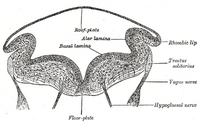
Photo from wikipedia
Theories of neural coding in the taste system typically rely exclusively on data gleaned from taste-responsive cells. However, even in the nucleus tractus solitarius (NTS), the first stage of central… Click to show full abstract
Theories of neural coding in the taste system typically rely exclusively on data gleaned from taste-responsive cells. However, even in the nucleus tractus solitarius (NTS), the first stage of central processing, neurons with taste selectivity coexist with neurons whose activity is linked to motor behavior related to ingestion. We recorded from a large ( n = 324) sample of NTS neurons recorded in awake rats, examining both their taste selectivity and the association of their activity with licking. All subjects were implanted with a bundle of microelectrodes aimed at the NTS and allowed to recover. Following moderate water deprivation, rats were placed in an experimental chamber where tastants or artificial saliva (AS) were delivered from a lick spout. Electrophysiological responses were recorded, and waveforms from single cells were isolated offline. Results showed that only a minority of NTS cells responded to taste stimuli as determined by conventional firing-rate measures. In contrast, most cells, including taste-responsive cells, tracked the lick pattern, as evidenced by significant lick coherence in the 5- to 7-Hz range. Several quantitative measures of taste selectivity and lick relatedness showed that the population formed a continuum, ranging from cells dominated by taste responses to those dominated by lick relatedness. Moreover, even neurons whose responses were highly correlated with lick activity could convey substantial information about taste quality. In all, data point to a blurred boundary between taste-dominated and lick-related cells in NTS, suggesting that information from the taste of food and from the movements it evokes are seamlessly integrated. NEW & NOTEWORTHY Neurons in the rostral nucleus of the solitary tract (NTS) are known to encode information about taste. However, recordings from awake rats reveal that only a minority of NTS cells respond exclusively to taste stimuli. The majority of neurons track behaviors associated with food consumption, and even strongly lick-related neurons could convey information about taste quality. These findings suggest that the NTS integrates information from both taste and behavior to identify food.
Journal Title: Journal of neurophysiology
Year Published: 2019
Link to full text (if available)
Share on Social Media: Sign Up to like & get
recommendations!